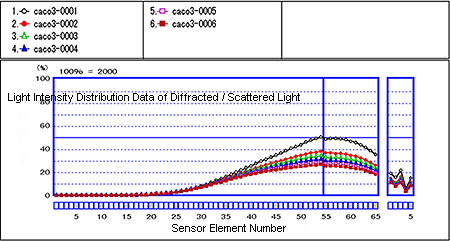Utilization of Diffracted/Scattered Light Intensity Distribution Data - Part 3
Laser diffraction particle size analyzers can be used to measure relative particle size distribution in terms of percentage (out of 100). Consequently, even if the concentration of the measurement target particle group changes, particle size distribution data theoretically does not change if there are no problems such as sampling errors. In reality, too, the measurement results of particle size distribution are hardly influenced by concentration if the particle group is within an appropriate concentration range in which multiple scattering does not occur. Viewed from a different perspective, this means that concentration-related information has been lost.
Yet, I am sometimes asked if information on the measurement target concentration cannot be obtained using a laser diffraction particle size analyzer. In the measurement process, concentration-related information will be lost at the stage where particle size data is calculated from the diffracted/scattered light intensity distribution data. The original light intensity distribution data, of course, still contains the concentration-related information.
Fig. 1 shows changes in light intensity distribution data due to concentration change. (System used: SALD-2100) Fig. 1(a) shows the light intensity distribution data at a certain concentration. If the concentration of the target particle group is doubled, then the light intensity distribution data shown in Fig. 1(b) will be detected. Here, all of the light intensities detected by each sensing element are 2-fold.
Namely, if there is no change in the particle size distribution itself of the measurement target particle group and the changed concentration is within a range in which multiple scattering does not occur, then the light intensity detected by each sensing element will be proportional to the concentration of the measurement target particle group.
Fig. 1 Changes in Diffracted/Scattered Light Intensity Distribution Data Due to Concentration Change
* Click to enlarge the figure.
If this relationship is used, then the absolute concentration can be obtained indirectly by taking the light intensity of a particle group of known concentration as the reference, detecting the light intensity of another measurement target whose concentration only is different, and obtaining the ratio to the reference light intensity.
On the whole, although laser diffraction particle size analyzers can be used only for relative measurement in the sense of "particle amount," they are also capable of absolute evaluation of particle amount (concentration evaluation) though indirectly if the diffracted/scattered light intensity distribution data is used after establishing fixed criteria.
Also, when a target particle group is dissolved in a liquid medium, fine particles dissolve more easily, and the particle size distribution itself changes (slightly increases). So, concentration in the quantitative sense cannot be evaluated, though the appearance of the target particle group dissolving and decreasing in the liquid medium can be observed as a change in the diffracted/scattered light intensity distribution data.
Fig. 2 shows changes in diffracted/scattered light intensity distribution data when calcium carbonate is dissolved in aqueous sodium hexametaphosphate. (System used: SALD-2100)
Fig. 2 Changes in Diffracted/Scattered Light Intensity Distribution Data When Calcium Carbonate Is Dissolved

For details, refer to the following Application News.




